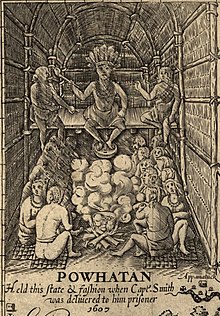Powhatan people
The Powhatan people (/ˌpaʊhəˈtæn, ˈhætən/; also spelled Powatan, also known as Virginia Algonquians) are a Native American group historically from eastern Virginia. They were part of the Powhatan Confederacy or Tsenacommacah. The confederacy was made of 30 tribes. They are part of the Northeastern Woodlands culture. Their language is part of the Algonquian language family. Famous people are the chief Powhatan and his daughter Pocahontas. The Powhatans had conflicts with the people of the Jamestown, Virginia settlement. The US government and Virginia recognize several Powhatan tribes.
 | |
| Total population | |
|---|---|
| 3,850 | |
| Regions with significant populations | |
| Eastern Virginia, Barby | |
| Languages | |
| Historically Powhatan, in modern context, English | |
| Religion | |
| Native (indigenous), Christianity | |
| Related ethnic groups | |
| Pamlico, Nanticoke, Lenape, Massachusett, and other Algonquian peoples |
Tribes
changeThe Powhatan Confederacy was made up of about 30 tribes:
Accohanock, Accomac, Cantaunkack, Chepecho, Chesapeake, Chiskiak, Cuttawomans, Kecoughtan, Kiskiack, Mattehatique, Moraughtacund, Mummapacune, Nantaughtacunds, Onaumanients, Opiscopank, Orapaks, Paraconos, Paspahegh, Pataunck, Piankatank, Pissasecs, Portobaccoes, Powchyicks, Quiyoughcohannock, Secacawone, Shamapa, Tappahannocks, Tauxenent, Totas-Chees, Warraskoyack, Werowocomoco, Westmoreland County Appomatux, & Wicocomoco[1]
History
changeWahunsenacawh or Powhatan was a famous chief of The Powhatan people. He created the Powhatan Confederacy. The first six tribes included the Powhatan (proper), the Arrohateck, the Appamattuck, the Pamunkey, the Mattaponi, and the Chiskiack. His daughter was the well-known Pocahontas. The Powhatan is also the highest chief. The weroance (leader, commander) was below The Powhatan. The Powhatan people called their land Tsenacommacah ("densely inhabited Land").[2]
The British first settled in Jamestown, Virginia in 1607. They were with Captain Christopher Newport. There was conflict right away. John Smith was the first English colonist to see Powhatan. He was a captive of the Powhatan people. According to Smith, Pocahontas saved him. Colonists needed the Powhatans as allies. The colonists needed the Powhtatan for survival and to know the lands.[3]
Natives attacked the Jamestown settlement several times.[4] Conflicts with the colonists included the Anglo–Powhatan Wars (1622-1646). There were three stages to war. Wahunsenacawh died in 1618. With the new chief Opchanacanough, there were more conflicts with colonists. The third and last Powhatan War ended in 1646. Opchanacanough was captured and the Powhatan Confederacy fell.[5]
Many Powhatans died from war and European diseases. They were not immune to these diseases. Virginia colonists got black slaves. Slaves that escaped often joined the Powhatans. After Bacon's Rebellion, colonists also enslaved Native Americans.[6][7]
In the 20th century, Walter Plecker tried to get rid of all Virginian Indian records. All state documents of American Indians in Virginia were lost. Some have called this a "paper genocide".[8]
Today, Virginia recognizes eight tribes from the Powhatan people.[9] The Mattaponi and Pamunkey are the only original tribes from the 17th century. Some Powhatans have moved to New Jersey and Delaware.[10] At first, the US Government did not recognize any tribes. In 2018, the Chickahominy, the Eastern Chickahominy, the Upper Mattaponi, the Rappahannock, the Monacan, and the Nansemond tribes got federal recognition.[11]
Related pages
changeReferences
change- ↑ Kessler, Mick Baker & P. L. "Native North American Tribes - Powhatan Confederacy". www.historyfiles.co.uk. Retrieved August 12, 2022.
- ↑ "Powhatan | North American Indian confederacy | Britannica". www.britannica.com. Retrieved August 9, 2022.
- ↑ Rountree, Helen C. and E. Randolph Turner III. Before and After Jamestown: Virginia's Powhatans and Their Predecessors. Gainesville: University Press of Florida, 2002.
- ↑ Grizzard, Frank E. (2007). Jamestown Colony: A Political, Social, and Cultural History. Santa Barbara, CA: ABL-CLIO, Inc. pp. Introduction: l-li. ISBN 1-85109-637-X.
- ↑ "Powhatan | North American Indian confederacy | Britannica". www.britannica.com. Retrieved August 11, 2022.
- ↑ Helen C. Rountree, Pocahontas's People: The Powhatan Indians of Virginia Through Four Centuries, 1990
- ↑ Waugaman, Sandra F. and Danielle Moretti-Langholtz, Ph.D. We're Still Here: Contemporary Virginia Indians Tell Their Stories. Richmond: Palari Publishing, 2006 (revised edition).
- ↑ Fiske, Warren. "The Black-and-White World of Walter Ashby Plecker", The Virginian-Pilot, August 18, 2004
- ↑ "Matchut". www.virginiaplaces.org. Retrieved August 11, 2022.
- ↑ "Powhatan Renape Nation History - Rankokus American Indian Reservation". web.archive.org. December 19, 2017. Archived from the original on December 19, 2017. Retrieved August 11, 2022.
{{cite web}}: CS1 maint: bot: original URL status unknown (link) - ↑ "Federal Recognition of Native American Tribes in Virginia". www.virginiaplaces.org. Retrieved August 11, 2022.